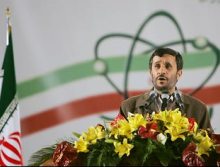
Iran is poised to make a significant leap in its ability to enrich uranium, with more sophisticated centrifuge technology that is being assembled in secret to advance the country’s nuclear efforts, according to U.S. and European intelligence officials and diplomats.
Iran’s apparent gains in centrifuge technology have heightened concerns that the government is working clandestinely on a uranium-enrichment plant capable of producing more nuclear fuel at a much faster pace, the officials said.
U.N. nuclear monitors have not been allowed to examine the new centrifuge, which Iranian officials briefly put on display at a news conference this month. But an expert group’s analysis of the new machine — based on photos — suggests that it could be up to five times more productive than the balky centrifuges Iran currently uses to enrich uranium.
Assuming the country has so far produced only prototypes of the centrifuge, it will probably take it another two years, or more, to assemble enough machines to make enough enriched uranium for a nuclear weapon. After that, though, Iran would be in a position to ramp up production dramatically, depending on how many machines it decides to install.
Using its existing centrifuges, Iran has made more than two tons of low-enriched uranium, an amount that officials say could be further enriched to produce enough weapons-grade material for about two nuclear bombs, even as the government insists that its nuclear program is exclusively for energy production.
Iran’s progress on a new centrifuge coincides with a marked decline in activity at its two known uranium-enrichment plants, sources said, spurring speculation that it plans to use the new centrifuge at a still-unknown facility.
One of the known plants, a small, heavily fortified facility built in a mountain tunnel near the city of Qom, has been all but idle in recent months. Construction work has slowed to a near halt in the weeks since the facility was publicly revealed in September, according to two Europe-based diplomats privy to intelligence reports about the site.
“They seem to have lost interest in Qom since its discovery,” said the diplomat, who, like others, requested anonymity while discussing sensitive intelligence about Iran’s nuclear program. “It makes us wonder if they’re thinking about a new site.”
A second diplomat confirmed that inspectors had seen a sharp drop-off in activity at Qom, prompting questions about the whereabouts of scores of highly trained scientists and workers seen there during visits six months ago. “They do not have enough trained people to work in multiple places,” the official said.
Iran’s largest enrichment facility, an underground complex near the city of Natanz, also appears to have stalled. Originally built to house 50,000 first-generation centrifuges known as IR1s, Natanz had only about 3,800 functioning machines when U.N. inspectors visited in late January, down from nearly 5,000 working IR1s the previous spring.
In uranium enrichment, centrifuges spin a gasified form of uranium at supersonic speeds to create the enriched fuel used in commercial nuclear power plants, as well as in nuclear weapons.
The IR1 centrifuge used at Natanz is based on a 1950s Dutch design that Pakistani scientist Abdul Qadeer Khan stole and sold to the Iranians. The machine is prone to crashing, and was quickly abandoned by other countries that used it.
The new machine displayed by Iran leaps ahead by at least two generations, according to diplomatic sources and nuclear experts. One diplomat said the new machine on display was “probably an IR5,” adding that the U.N. officials do not yet know how Iran developed the centrifuge, or who might have provided assistance.
“We don’t know where these are supposed to be going,” the official said.
An analysis by the nonprofit Institute for Science and International Security concluded that new machine is made of rare, hard-to-make metals such as carbon fiber, and has been substantially redesigned to increase efficiency. While Iran has offered no test data, the machine appears “theoretically capable” of producing enriched uranium at a rate five times faster than the IR1, the Washington-based nuclear research group said.
David Albright, ISIS president and co-author of the analysis, said it is legitimate to suspect that a new centrifuge plant is under construction, though it is unclear where Iran would acquire the uranium feedstock to use in such a facility. After being forced to acknowledge the existence of the Qom site, Iran may well have decided to start another enrichment plant to keep its nuclear options open, he said.
“The logic is that, if a site is discovered, start building another one or two,” Albright said.
Iran has a limited amount of natural uranium, but it has already produced uranium hexafluoride, the feedstock for centrifuges, to keep them running for years.
Ali Akbar Salehi, Iran’s nuclear energy chief, was vague when asked during a CBS interview about new facilities. “We say start — we probably will start — another site this year,” Salehi said. He added that Iran does not intend to notify the U.N. nuclear agency about the new construction until the facility is nearly ready to begin operating.
After being embarrassed publicly by revelations about the secret Qom plant, Iranian President Mahmoud Ahmadinejad boasted that Iran would soon build 10 new enrichment plants. Washington Post
Leave a Reply
You must be logged in to post a comment.